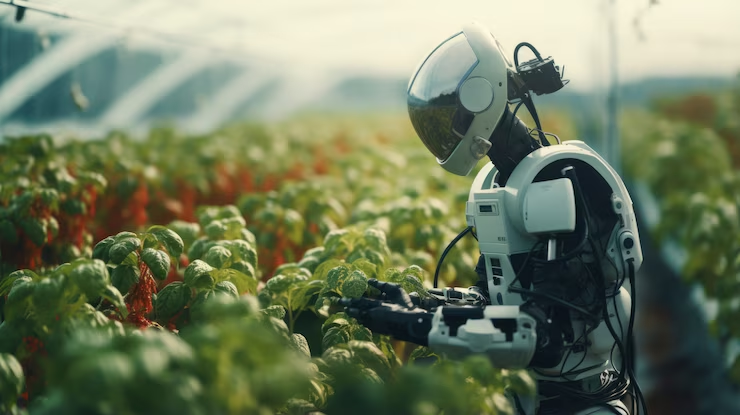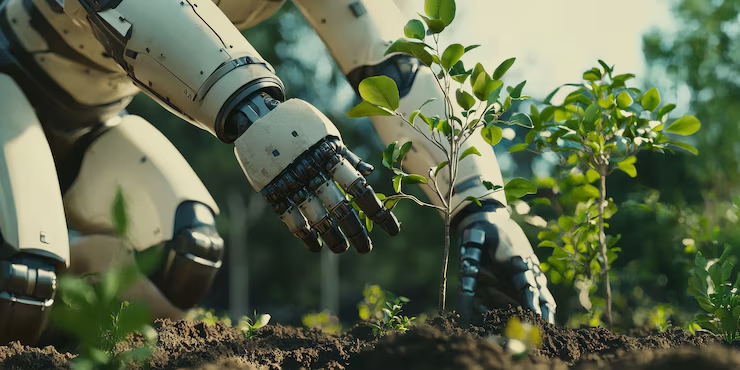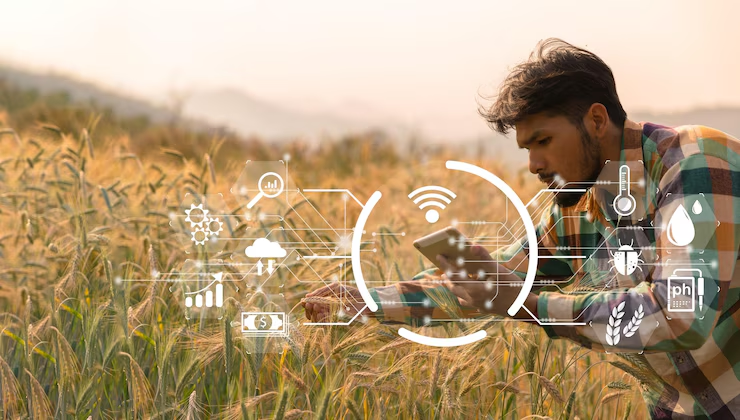Artificial Intelligence in Agriculture: Transforming the Future of Farming
Introduction :
Agriculture, the backbone of human civilization, is undergoing a significant transformation with the advent of Artificial Intelligence (AI). As the global population rises and climate change poses new challenges, the integration of AI into farming practices offers innovative solutions to enhance productivity, sustainability, and efficiency. This blog delves into the multifaceted applications of AI in agriculture, its benefits, challenges, and the future it holds for the farming industry.
________________________________________
1. The Need for AI in Modern Agriculture
Traditional farming methods are increasingly insufficient to meet the demands of a growing population and the complexities of modern agriculture. Challenges such as unpredictable weather patterns, pest infestations, soil degradation, and resource limitations necessitate the adoption of advanced technologies. AI emerges as a pivotal tool to address these issues by enabling data-driven decision-making and automation.
________________________________________
2. Applications of AI in Agriculture
2.1 Precision Farming
Precision farming involves the use of AI to analyze data from various sources like satellite imagery, sensors, and weather forecasts to make informed decisions about planting, watering, and harvesting. This approach optimizes resource usage and increases crop yields.
2.2 Crop Monitoring and Disease Detection
AI-powered drones and imaging technologies can monitor crop health in real-time, identifying signs of disease, pest infestations, or nutrient deficiencies. Early detection allows for timely interventions, reducing crop losses.
2.3 Soil and Weather Analysis
AI algorithms process data from soil sensors and weather stations to provide insights into soil health and weather patterns. This information aids farmers in selecting suitable crops and determining optimal planting times.
2.4 Automated Irrigation Systems
Smart irrigation systems utilize AI to assess soil moisture levels and weather forecasts, ensuring crops receive the right amount of water at the right time, conserving water and improving plant health.
2.5 Yield Prediction
Machine learning models analyze historical data and current conditions to predict crop yields accurately. This helps in planning storage, marketing, and distribution strategies.
2.6 Weed and Pest Control
AI-driven robots and drones can identify and target weeds or pests, applying herbicides or pesticides precisely where needed, minimizing chemical usage and environmental impact.
2.7 Supply Chain Optimization
AI enhances supply chain efficiency by predicting demand, optimizing logistics, and reducing food waste through better inventory management.
________________________________________
3. Benefits of AI in Agriculture
3.1 Increased Productivity
By automating tasks and providing precise recommendations, AI helps farmers increase crop yields and overall productivity.
3.2 Resource Efficiency
AI ensures optimal use of water, fertilizers, and pesticides, reducing waste and lowering costs.
3.3 Environmental Sustainability
Targeted application of inputs and efficient resource management contribute to sustainable farming practices, reducing the ecological footprint.
3.4 Risk Mitigation
Predictive analytics enable farmers to anticipate and prepare for adverse weather conditions or pest outbreaks, minimizing potential losses.
3.5 Labor Optimization
Automation of labor-intensive tasks addresses labor shortages and allows human workers to focus on more strategic activities.
________________________________________
4. Challenges in Implementing AI in Agriculture
4.1 High Initial Investment
The cost of acquiring and maintaining AI technologies can be prohibitive for small-scale farmers.
4.2 Technical Expertise
Implementing AI solutions requires technical knowledge, which may be lacking in rural farming communities.
4.3 Data Privacy and Security
Collecting and processing large amounts of data raise concerns about data ownership, privacy, and security.
4.4 Infrastructure Limitations
Reliable internet connectivity and power supply are essential for AI systems, which may be lacking in remote agricultural areas.
4.5 Adaptation to Local Contexts
AI models need to be tailored to specific regional conditions, crops, and farming practices to be effective.
________________________________________
5. Case Studies: AI in Action
5.1 India: KissanAI's Dhenu 1.0
KissanAI developed Dhenu 1.0, an AI-powered assistant designed for Indian farmers. It provides voice-based, multilingual support, offering tailored agricultural advice and information on government schemes.
5.2 United States: Smart Sprayers
Researchers at the University of Florida developed AI-powered sprayers that identify weeds and apply herbicides precisely, reducing chemical usage by up to 90% and lowering costs for growers.
5.3 Kenya: Virtual Agronomist
In Kenya, small-scale farmers use AI tools like Virtual Agronomist to receive personalized advice on fertilization and pest control, significantly increasing crop yields.
________________________________________
6. The Future of AI in Agriculture
6.1 Integration with IoT
Combining AI with the Internet of Things (IoT) will enable real-time monitoring and management of farm operations, enhancing decision-making and efficiency.
6.2 Development of Affordable Solutions
As technology advances, the cost of AI tools is expected to decrease, making them accessible to a broader range of farmers, including those in developing countries.
6.3 Policy and Education Initiatives
Governments and organizations need to invest in training programs and infrastructure development to support the adoption of AI in agriculture.
6.4 Sustainable Farming Practices
AI will play a crucial role in promoting sustainable agriculture by optimizing resource use and reducing environmental impact.
________________________________________
7. AI-Powered Innovations in Agriculture
7.1 AI-Driven Drones for Early Disease Detection
In India, researchers have developed AI-based drones equipped with edge computing capabilities to monitor cashew plantations. These drones can detect diseases like anthracnose in cashew leaves with up to 95% accuracy, allowing for timely interventions and reducing crop losses. arXiv
7.2 Autonomous Weeding Robots
FarmWise, a U.S.-based company, has introduced the Titan FT-35, an AI-powered weeding robot. This machine uses computer vision and machine learning to distinguish between crops and weeds, enabling precise weed removal without harming the crops, thus reducing the need for chemical herbicides. Wikipedia+1AIEean.io -+1
7.3 AI in Livestock Monitoring
In Queensland, Australia, the Department of Agriculture and Fisheries, in collaboration with InFarm, has developed an AI-based camera system to monitor cattle. This technology assesses animal health, detects injuries, and monitors fertility rates, enhancing livestock management and productivity. couriermail
________________________________________
8. Benefits of Integrating AI in Agriculture
8.1 Enhanced Crop Yields
AI algorithms analyze various data points, including soil health, weather patterns, and crop history, to provide recommendations that optimize planting schedules and resource allocation, leading to increased yields.
8.2 Resource Optimization
AI-driven systems ensure efficient use of water, fertilizers, and pesticides by applying them precisely where needed, reducing waste and environmental impact.
8.3 Predictive Analytics
By forecasting weather conditions and potential pest outbreaks, AI enables farmers to take proactive measures, safeguarding crops and minimizing losses.
________________________________________
9. Challenges in AI Adoption in Agriculture
9.1 High Initial Investment
The cost of implementing AI technologies, such as drones, sensors, and automated machinery, can be prohibitive for small-scale farmers. Appic Softwares
9.2 Technical Expertise
Effective utilization of AI tools requires technical knowledge, which may be lacking in rural farming communities. Training and support are essential for successful adoption.
9.3 Data Privacy and Security
The collection and analysis of vast amounts of agricultural data raise concerns about data ownership, privacy, and security.
________________________________________
10. Global Case Studies
10.1 Kenya: Virtual Agronomist and PlantVillage
In Kenya, smallholder farmers are leveraging AI tools like Virtual Agronomist and PlantVillage to receive tailored advice on fertilization and pest control. These tools have significantly increased crop yields and reduced costs, demonstrating AI's potential in enhancing food security. The Guardian
10.2 Netherlands: AI in Tulip Farming
Dutch tulip farmers are employing AI-powered robots to detect and remove diseased plants, combating the spread of tulip-breaking virus. This technology replaces traditional human "sickness spotters," addressing labor shortages and improving efficiency. AP News
________________________________________
11. Future Prospects
The integration of AI in agriculture is poised to revolutionize farming practices, making them more efficient, sustainable, and resilient. Continued investment in research, infrastructure, and education is crucial to overcome existing challenges and ensure that farmers worldwide can benefit from these advancements.
Conclusion
Artificial Intelligence is revolutionizing agriculture by offering innovative solutions to age-old challenges. While there are hurdles to overcome, the potential benefits of AI in enhancing productivity, sustainability, and resilience in farming are immense. Embracing AI technologies will be essential for feeding a growing global population and ensuring the long-term viability of agriculture.





